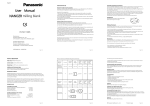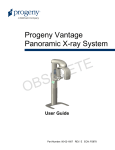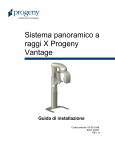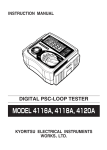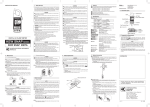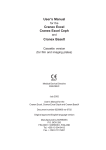Download Operating Instructions
Transcript
Intraoral Camera EJ-CA02EPA ≥ Please read these instructions carefully before using this product, and save these instructions for future use. ≥ The information contained in the Safety Precautions (P. 4 – P. 8) is important for the safe and reliable operations of the product. Read and understand the information thoroughly before attempting to set up and operate the product. ≥ Compliant with medical safety standards This design complies with EN 60601-1, ANSI/AAMI ES 60601-1 and CAN/CSA-C22.2 NO. 60601-1-08 safety standards, meeting the requirements for use in the medical field. Customer’s Record The serial number of this product can be found on the Logo sheet of Camera handpiece. You should note this serial number in the space provided below and retain this book, plus your purchase receipt, as a permanent record of your purchase to aid identification in the event of theft or loss, and for Warranty Service purposes. Model Number Serial Number Other Using with a PC Preparation Model No. Safety Precautions Operating Instructions Introduction This Intraoral Camera can capture and display the inside of a patient’s mouth, when it is connected to the USB 2.0 terminal of the PC and supplied the power from it. This product achieves accurate color reproducibility inside the mouth, and it helps you to capture clear images the first time around with its auto focus and stabilization correction features. The product is intended to be used to assist in providing explanations to your patients. Captured pictures are not intended to be used for an image diagnosis. Note . . . . . . . . . . . . . . . . . . . . . . . . . . . . . . . . . . . . . . . . . . . . . . . . . . . . . . . . . 2 To the customer: This product is a medical device, and the user must be completely familiar with its operation. Read thoroughly each of the items in the Operating Instructions. To the dealer: After attaching the product, be sure to adequately explain each of the items in these Operating Instructions to the customer to ensure safety. Table of Contents Read “Safety Precautions” (P.4 – P.8) thoroughly before use. Safety Precautions Safety Precautions (These must be observed) . . . . . . . . . . . . 4 Information for your safety . . . . . . . . . . . 8 Preparation Before using . . . . . . . . . . . . . . . . . . . . . . . 9 Safety Precautions Introduction . . . . . . . . . . . . . . . . . . . . . . . 2 Accessories . . . . . . . . . . . . . . . . . . . . . . . . 10 Recommended Disposable cover. . . . . . . 10 Product display symbols . . . . . . . . . . . . . . 13 Fitting / Removing the Disposable cover . . . . . . . . . . . . . . . . . . . . 15 Using with a PC Operating environment for EJ-CA02EPA. . . 18 Preparation Part names and functions . . . . . . . . . . . . 11 Connecting to a PC . . . . . . . . . . . . . . . . . . 19 Disconnecting from a PC . . . . . . . . . . . . . 20 Maintenance . . . . . . . . . . . . . . . . . . . . . . . 21 Troubleshooting . . . . . . . . . . . . . . . . . . . . 22 Specifications . . . . . . . . . . . . . . . . . . . . . . 23 EMC Relevant Information . . . . . . . . . . . 24 Other Other Using with a PC Capturing images and Playing back images on a PC . . . . . . . . . . . . . . . . . . . . . 20 3 Safety Precautions (These must be observed) The following symbols describe the need to observe certain content in order to prevent human injury or damage to property. ? These describe and classify the degree of injury or damage that occurs with incorrect use. WARNING This indicates “content that involves a risk of serious injury or death”. CAUTION This indicates “content that involves a risk of injury or damage to property”. ? The following symbols describe content to be observed. (The following symbols are examples.) This indicates “content that must NOT be performed”. This indicates “content that MUST be performed”. WARNING Use the Intraoral Camera after fitting the specified Disposable cover (LSFB0030). Using the Intraoral Camera without fitting the specified Disposable cover could cause infection, device breakage and accidental ingestion of broken parts. Use a new Disposable cover for each patient. Reusing the Disposable cover could cause infection. Before and after using the product, wipe it with gauze or a similar material containing ethanol for disinfection. Using the product in an unsanitary condition could cause infection. 4 Do not use a torn Disposable cover. If you use a torn Disposable cover, it may cause infection or the Camera handpiece malfunction. Do not use a damaged Camera handpiece. This could cause accidental ingestion of damaged parts or electric shock. The PC connected to this product must conform to IEC 60950-1 or IEC 60601-1. Safety Precautions WARNING When connecting this product to other devices, there is a risk that the leakage current may increase. The combination and installation shall conform to IEC 60601-1:2005. Any person who connects this product is responsible for ensuring that the system conforms to IEC 60601-1:2005. If there is anything that you do not understand, please contact the dealer where this product was purchased. If there is lightning or thunder, do not touch the product or the devices to which it is connected (PC, USB plug). This could cause electric shock. Do not damage the Camera cable. (Do not scratch, modify, put near hot devices, forcibly turn, twist, tug, place heavy items upon, or knot). Using these when damaged could cause fire, electric shock or short-circuiting. ≥ For repairs of the cable, please contact your dealer. Only the supplied Camera cable (LSYC2149) should be used. Using a cable other than the one supplied with this product could cause electric shock or short-circuiting. When the LED light of the product is illuminated, do not look directly into the LED light from close-up, and do not shine it in a person's eyes. This product uses IEC 60825-1 class I LED. Intense light could hurt the eyes. 5 Safety Precautions (These must be observed)–Continued WARNING Do not directly touch the product for a long period of time with the power turned on. The temperature of the LED light exceeds 41 °C (it reaches to maximum 46 °C after 10 minutes of use). In order to prevent burns caused by heat, be careful not to let the LED light part continuously touch the inside of the patient's mouth. Direct, prolonged contact with the hot parts of the product could cause low-temperature burns*. * Persons that have poor blood flow (vascular disorders, blood circulation impairment, diabetes, high blood pressure) or persons that have weak skin sensation, etc. tend to get low-temperature burns. Do not use this product near persons that use pacemakers and other similar devices. The radio waves from this product could affect the operation of pacemakers, etc. Do not use the Camera handpiece when it is wet. This could cause electric shock or product malfunction. Do not pour water on or wet the product. This product does not have water proof structure. Water getting inside the product could cause fire, electric shock, or product malfunction. If water gets inside the product, contact your dealer. Do not disassemble or modify the product. ≥ Order repairs and inspections of the inside of the product from your dealer. Operator must not touch the patient and the PC connected to this product simultaneously. This could cause electric shock. Prevent a patient from touching the PC connected to this product. Camera handpiece and Camera cable are suitable for use within the patient environment. 6 Operator must not touch the patient and the metal part of Camera cable connected to the PC simultaneously. This could cause electric shock. Do not connect additional multiple socket-outlets or extension cord for power supply to the Intraoral Camera system. Safety Precautions WARNING This could cause electric shock. CAUTION To avoid an infection risk, when disposing of this Intraoral Camera, you must obey the laws applicable in your area and country and comply with the regulations of your hospital. When performing maintenance or when the product is not to be used for a long period of time, disconnect the USB plug to ensure safety. Leaving or storing while plugged in could cause insulation degradation, short-circuiting, etc., which could cause a fire. In the following situations, stop using it and disconnect the USB plug; — smoke rise from the product, — the product is abnormally hot, — the product smells burnt, — abnormal noise is heard from the product, — if water or foreign bodies get inside the product, — the external case of the product is damaged. Continuing to use the product could cause fire or electric shock. Do not place the product in an unstable location (On an uneven table or an incline, etc.). If the product falls, this could cause injury or product malfunction. 7 Information for your safety General ≥ Please read these safety instructions carefully. ≥ Please keep this Operating Instructions for later reference. To prevent the damage ≥ Do not drop or knock this product or put a lot of pressure on it. This may damage this product. ≥ Do not expose this product to excessive heat or direct sunlight as to avoid the risk of fire. ≥ Handle this product with care. Rough handling will damage its internal components. Use this product in the appropriate position ≥ To avoid risk of electrical damage, keep this product away from fluids and chemicals. ≥ Do not use this product near inadequately shielded medical devices. ≥ Do not use this product near electromagnetic equipment, radio transmitters or high voltage lines. Do not use this product in the following locations ≥ In environments with a high oxygen content in the atmosphere. ≥ In proximity to anesthetic gas (i.e. in a flammable atmosphere). ≥ In an atmosphere containing oxidized materials. For cleaning or storage ≥ Please disconnect this product from USB 2.0 terminal before cleaning. Do not use liquid or sprayed detergent for cleaning. Use moisture sheet or cloth for cleaning. ≥ Please keep this product away from humidity. Contact to the dealer ≥ Do not remove any parts of this product. Contact an authorized dealer in your area. ≥ If one of the following situations arises, get this product checked by service personnel: - The Camera cable or USB plug is damaged. - Liquid has penetrated into this product. - This product has been exposed to moisture. - This product has not worked well or you can not get it work according to Operating Instructions. - This product has dropped and damaged. - If this product has obvious sign of breakage. 8 Before using Handling this product ≥ Do not touch the lens or terminal with hands. Also, be careful to prevent liquid and foreign materials from getting into the product from the lens or button gaps. ≥ Do not bend, tug and twist the joint of the Camera handpiece and the Camera cable to avoid damaging the Camera cable. ≥ Do not use devices that emit electromagnetic radiation near this product. The electromagnetic radiation emitted by communication devices such as mobile phones, transceivers, etc. can affect this device and lead to glitches that cause the product to malfunction. In a clinical setting, instruct that these communication devices be turned off. ≥ Do not use lights that emit electromagnetic radiation near this product. The electromagnetic radiation emitted from an inverter operation light (film viewer, fluorescent light, etc.) could affect the image. Indemnity about recorded content ≥ Panasonic does not accept any responsibility for damages directly or indirectly due to any type of problems that result in loss of recorded content, and does not guarantee any content if recording does not work properly. Preparation ≥ When operating or transporting this product, hold the main part of the Camera handpiece. If the product is held dangling by grabbing the Camera cable, the Camera handpiece could hit the floor or other medical devices, causing it to become damaged or to malfunction. Safety Precautions ≥ Do not exert strong shocks or vibrations on the product by dropping it, hitting it, etc. Also, do not apply strong pressure to the product. This could cause the product to malfunction, impossible recording, or damage to occur to device parts such as the lens. 9 Accessories Check the accessories. Camera cable ···1 LSYC2149 Cable bush for silicon tube ···1 LSMG0238 * 2.3 m/Shielded * Detachable parts * Detachable parts Operating Instructions ···1 LSQT1719 Recommended Disposable cover The following Disposable cover shall be used with this product. TIDI products, LLC/Camera Sheaths Model No.: LSFB0030 500 sheets/Box For Purchasing Disposable covers Contact the dealer for information related to purchasing Disposable covers. 10 Part names and functions Camera handpiece In this document, the main unit part of the product (figure below) is called the Camera handpiece. (Excluding the cable) ≥ Camera handpiece (excluding the Camera cable) is the BF type applied part. 1 POWER indicator POWER indicator shows status of this product as table below. Operating State POWER indicator Status Operating Glows Green Normal Standby No power supply Glows Orange Normal Flashes Orange Malfunction Goes out Disconnected Preparation Note: The following case, please see the troubleshooting. (P.22) ≥ Status shows malfunction. ≥ POWER indicator goes out when the Camera handpiece and the Camera cable are connected. 2 POWER button Switch the state Operating and Standby. 3 ZOOM button This switches the modes of the product as shown below. Normal # Zoom # Normal (return) ≥ In Zoom mode, the image is displayed 1.5 times larger than the Normal. ≥ Once the Power goes to Standby, Zoom mode returns to Normal. <Normal> <Zoom> x 1.5 11 Part names and functions – Continued 4 LIGHT button Turns the LED light on or off. When goes to Operating, the LED light automatically turns on. Note: ≥ When capturing extraoral images, turn off the LED light. Failure to do so could result in images becoming unclear. 5 Shutter button This captures still pictures. The button is in 2 places, top and bottom. The button that is easiest to press can be used according to the direction of the lens. When the lens is turned upward When the lens is turned downward 6 LED light The light illuminates objects. 7 Lens This is the Lens which captures still and moving pictures. The front surface of the lens is protected by cover glass. 8 Camera cable This connects to the Camera handpiece and the USB 2.0 terminal on the PC. 12 Product display symbols These describe the symbols displayed on the product and the meaning of those symbols. The device complies with the Medical Device Directive 93/42/EEC. Type BF Applied Part This symbol indicates this product complies with requirements for the BF type applied part according to IEC 60601-1. European Commission Directive 2002/96/EC related to the disposal of electric and electronic devices applies to this product. USB plug Preparation LED light POWER ON STANDBY Serial number Manufacturer and/or Manufacturing date Authorised representative in the European community Consult operating instruction for use. Temperature limits 13 Product display symbols – Continued Keep away from rain Fragile Stacking limit by number This way up Recycling symbol for corrugated cardboard used for packaging Weight 14 Fitting / Removing the Disposable cover To prevent infection, damage to the product, and accidental ingestion of parts, the specified Disposable cover (LSFB0030) must be used. ≥ Use a new Disposable cover for each patient. The Disposable cover must not be reused. ≥ Check that the Disposable cover is not torn before use. ≥ Do not use the Camera handpiece when it is wet. This could cause infection or product malfunction. Before fitting the Disposable cover, wipe the Camera handpiece with a clean, soft cloth, such as gauze. ≥ Condensation on the Disposable cover could cause images to be unclear. If the image is unclear, remove the product from the patient's mouth, and wipe the part of the Disposable cover that covers the lens with a clean, soft cloth, such as gauze, then use. ≥ For reasons of hygiene, wear gloves when fitting and removing the Disposable cover, and dispose of used covers in an appropriate manner. ≥ When handling a Disposable cover with powdered gloves, it may be difficult to fit and remove the cover because the gloves slip. Use non-slip gloves and powder-free gloves. ≥ Store Disposable covers in a cool location away from sunlight. ≥ To avoid an infection risk, when disposing of the Disposable cover, you must obey the laws applicable in your area and country and comply with the regulations of your hospital. Fitting 1 Turn the Camera handpiece Lens downward. Hold the Disposable cover and insert the camera between the white tab and the paper with the optical side facing the paper. 2 Gently slide the camera until the camera head reaches the tip of the Disposable cover. Preparation Observe the following when fitting or removing the Disposable cover. ≥ Insert the camera to the cover so that the Camera handpiece is almost covered. 15 Fitting / Removing the Disposable cover – Continued 3 Peel back the protective top cover. 4 Peel away the paper backing. 5 Apply gentle pressure downward so sleeve is tight. Note: ≥ When fitting the Disposable cover, do not bend, tug and twist the joint of the Camera handpiece and the Camera cable to avoid damaging the Camera cable. 16 Removing 1 Pinch the hem of the Disposable cover. 2 Turn the Disposable cover toward the front end of the Camera handpiece. Note: ≥ When removing the Disposable cover, do not bend, tug and twist the joint of the Camera handpiece and the Camera cable to avoid damaging the Camera cable. Preparation ≥ Turn the Disposable cover over. Purchasing Disposable covers Contact the dealer for information related to purchasing Disposable covers. 17 Operating environment for EJ-CA02EPA Supported PCs IBM PC/AT compatible personal computer Mac (IEC 60950-1 applicable products) Application software UVC (USB Video Class) 1.0 compliant software Interface USB terminal (high-speed USB (USB2.0)) Other Keyboard Mouse or mouse-like pointing device Limitations ≥ Operation cannot be guaranteed for all PCs in the recommended environment. ≥ Operation on Tablet PC cannot be guaranteed. ≥ Operation cannot be supported on the NEC PC-98 series and compatible machines thereof. ≥ Operation is not guaranteed when 2 or more of Intraoral Camera have been connected to 1 PC or when Intraoral Camera is connected with a USB hub or USB extension cable. Notes ≥ Frame dropping, noise, or a slowdown of software operation could occur when capturing moving pictures if the CPU or memory is not fulfilling the requirements of the operating environment. ≥ Always use the most current driver for the video card. ≥ Always make sure there is enough capacity on the HDD in the PC. It may become inoperable or the operation may stop suddenly if the capacity gets low. Trademarks / Licenses ≥ IBM and PC/AT are registered trademarks of International Business Machines Corporation of the U.S. ≥ Mac is a trademark of Apple Inc., registered in the U.S. and other countries. ≥ In addition, listed names, company names and product names are a trademark or a registered trademark of each company. 18 Connecting to a PC This Intraoral Camera system is composed as following figure. Camera handpiece Camera cable PC (IEC 60950-1 applicable product) Camera handpiece ヒ Camera cable ビ PC Connect the attachment plug of Camera cable to the Camera handpiece. 1 Align all Marks of the Camera handpiece and the Plug and the Projected part. Insert the Plug into the deep inside of the Camera handpiece. Camera handpiece Mark Plug Mark Camera cable Projected part 2 Rotate the Plug 45 degrees clockwise and lock the connection. Confirm that positions of the Dot and the Mark are aligned. Using with a PC 1 rotate 45 degrees Dot Mark 19 Connecting to a PC – Continued Note: ≥ Do not insert or rotate the Plug forcibly. ≥ When disconnecting the Camera cable from the Camera handpiece, perform the reverse procedure of connecting the Camera cable. 2 Connect a USB terminal of the PC. Disconnecting from a PC 1 Press the POWER button on the Camera handpiece to be Standby mode. 2 Disconnect the USB plug from a USB terminal of the PC. Capturing images and Playing back images on a PC You can capture and playback images on your PC using application software for image management or viewer UVC 1.0 compliant. For details of capturing images and playing back images, refer to operating instructions of your software. 20 Maintenance Daily maintenance When performing maintenance, disconnect the USB plug. Main unit: Camera handpiece ≥ Use clean gauze containing ethanol for disinfection to wipe away the dirt. If the amount of ethanol for disinfection is too great when doing this, it might seep into the main unit from the connection parts, causing the product to malfunction. Also, do not disinfect by soaking or spraying. ≥ When the lens surface is dirty, a clear image cannot be captured. The lens must be cleaned. Gently wipe the lens surface. ≥ Because the quality or shape of the Camera handpiece could be altered, do not use the following disinfectants, solvents, detergents, etc. - Chemicals containing acetone, iodine, or phenols - Organic solvents such as benzine and thinner - Detergents such as kitchen detergent ≥ Also, if chemicals besides those used for daily maintenance get on the product, immediately wipe them away with ethanol for disinfection. ≥ Do not perform sterilization treatment using an autoclave or similar device. This could cause the product to malfunction. Camera cable ≥ Wipe with a soft cloth that contains a neutral detergent. ≥ When performing the maintenance of the Camera cable, do not bend, tug and twist it to avoid damaging the Camera cable. Setting / storage location Use care in selecting the setting / storage location. Not doing so could cause the product to malfunction. ≥ The acceptable ranges for ambient temperature, relative humidity, and atmospheric pressure are shown below. Ambient temperature Relative humidity Atmospheric pressure Usage conditions: 5 eC to 35 eC 10 % to 80 % 700 hPa to 1060 hPa Storage and transport conditions: —20 eC to 60 eC 5 % to 90 % 700 hPa to 1060 hPa ≥ Do not expose to direct sunlight for a long period of time. Other Check that there are no chips, cracks or dirt in the Camera handpiece or Camera cable. Do not use damaged devices. Before use, check that each part is operating correctly and safely. Not doing so could cause unexpected accidents or malfunction. Using with a PC Daily check ≥ Do not place in an unstable location. ≥ Do not use with a base of Camera cable bent. ≥ When using a product that has not been used for a long period of time, you must check that it operates normally and safely before use. 21 Troubleshooting Even if it appears that something is malfunctioning, it might be quickly fixed with a small operation or careful attention. Before ordering repairs from a dealer, check the following items. If the condition does not improve, contact the dealer where the product was purchased. Question Moving pictures do not appear on the PC screen Images are not clear POWER indicator goes out (The power cannot be turned on) POWER indicator flashes 22 Answer ≥ Check that the main screen of your viewer application is displayed on the PC. ≥ Check that the Camera cable is securely inserted into the USB 2.0 terminal on the PC. ≥ Check that the Disposable cover is not dirty. ≥ Check that the lens cover glass is not dirty. ≥ Check that the USB plug is securely inserted all the way to its base into the USB 2.0 terminal on the PC. ≥ Check that the Camera cable is securely inserted into the Camera handpiece. ≥ Contact the dealer where the product was purchased. Specifications General Usage conditions: ambient temperature / relative humidity / atmospheric pressure Ambient temperature: 5 °C to 35 °C Relative humidity: 10 % to 80 % Atmospheric pressure: 700 hPa to 1060 hPa Storage and transport conditions: ambient temperature / relative humidity / atmospheric pressure Ambient temperature: —20 °C to 60 °C Relative humidity: 5 % to 90 % Atmospheric pressure: 700 hPa to 1060 hPa Applied part classification Type BF applied part Power consumption DC 5 V 0.38 A Camera handpiece Main unit dimensions 237 mm k 29.5 mm k 36 mm (length k width k height) Mass Approx. 210 g (with Camera cable) PC interface USB2.0 (High speed) USB Device Class UVC 1.0 Imaging device 1/4 inches CMOS sensor (1.5 million pixels) Effective pixels 1 430 000 pixels Pixels of image 640 k 480 pixels (VGA) 5-group 6-element Auto Iris installed Open F-number 4.0 Lens Focal length 2.1 mm (35 mm film equivalent: 39.5 mm) Video image contrast detection Focus method (auto) LED light White LED 4 lights Stabilization correction Still picture: High-speed shutter Moving picture: Digital image stabilization Camera cable length 2.3 m IP Code IPX0 Other Focus range: 0 mm to ¶ 23 EMC Relevant Information 1 .The EJ-CA02EPA needs special precautions regarding EMC and needs to be installed and put into service according to the following EMC information. 2.The portable and mobile RF communications equipment can affect the EJ-CA02EPA. 3.WARNING: The EJ-CA02EPA should not be used adjacent to or stacked with other equipment. If adjacent or stacked use is necessary, the EJ-CA02EPA should be observed to verify normal operation in the configuration in which it will be used. 4.WARNING: The uses of accessories, transducers and cables, with the exception of transducers and cables sold by the manufacturer as replacement parts, may result in increased emissions or decreased immunity of the EJ-CA02EPA. 5.The EJ-CA02EPA is tested EMC to use general PC complied with IEC 60950-1. 6.Tests related to the AC power supply are not applicable. The EJ-CA02EPA is not connected to the public power supply and be supplied the power from USB terminal on a PC. Guidance and manufacturer’s declaration - electromagnetic emissions The EJ-CA02EPA is intended for use in the electromagnetic environment specified below. The customer or the user of the EJ-CA02EPA should assure that it is used in such an environment. Emissions test RF emissions CISPR 11 RF emissions CISPR 11 24 Compliance Group 1 Class A Harmonic emissions IEC 61000-3-2 Not applicable Voltage fluctuations/flicker emissions IEC 61000-3-3 Not applicable Electromagnetic environment - guidance The EJ-CA02EPA uses RF energy only for its internal function. Therefore, its RF emissions are very low and are not likely to cause any interference in nearby electronic equipment. The EJ-CA02EPA is suitable for use in all establishments other than domestic and those directly connected to the public low-voltage power supply network that supplies buildings used for domestic purposes. Guidance and manufacturer’s declaration - electromagnetic immunity The EJ-CA02EPA is intended for use in the electromagnetic environment specified below. The customer or the user of the EJ-CA02EPA should assure that it is used in such an environment. Immunity test IEC 60601 test level Compliance level Electromagnetic environment guidance Electrostatic discharge (ESD) IEC 61000-4-2 ± (2, 4, 6) kV contact ± (2, 4, 8) kV air ± (2, 4, 6) kV contact ± (2, 4, 8) kV air Floors should be wood, concrete or ceramic tile. If floors are covered with synthetic material, the relative humidity should be at least 30 %. Electrical fast transient/burst IEC 61000-4-4 ± 1 kV for interconnecting cable ± 1 kV for interconnecting cable Mains power quality should be that of a typical commercial or hospital environment. Surge IEC 61000-4-5 ± 1 kV line(s) to line(s) ± 2 kV line(s) to earth Not applicable Not applicable Voltage dips, short interruptions and voltage variations on power supply input lines IEC 61000-4-11 <5 % (>95 % dip in for 0.5 cycle Not applicable Not applicable 3 A/m Power frequency magnetic fields should be at levels characteristic of a typical location in a typical commercial or hospital environment. 40 % (60 % dip in for 5 cycles ) 70 % (30 % dip in for 25 cycles ) <5 % (>95 % dip in for 5 sec Power frequency (50 Hz/60 Hz) magnetic field IEC 61000-4-8 3 A/m ) is the a.c. mains voltage prior to application of the test level. Other NOTE ) 25 EMC Relevant Information – Continued Guidance and manufacturer's declaration - electromagnetic immunity The EJ-CA02EPA is intended for use in the electromagnetic environment specified below. The customer or the user of the EJ-CA02EPA should assure that it is used in such an environment. Immunity test IEC 60601 test level Compliance level Electromagnetic environment - guidance Portable and mobile RF communications equipment should be used no closer to any part of the EJ-CA02EPA, including cables, than the recommended separation distance calculated from the equation applicable to the frequency of the transmitter. Recommended separation distance Conducted RF IEC 61000-4-6 3 Vrms 150 kHz to 80 MHz 3 Vrms d =1.2 Radiated RF IEC 61000-4-3 3 V/m 80 MHz to 2.5 GHz 3 V/m d =1.2 80 MHz to 800 MHz d =2.3 800 MHz to 2.5 GHz where P is the maximum output power rating of the transmitter in watts (W) according to the transmitter manufacturer and d is the recommended separation distance in meters (m). Field strengths from fixed RF transmitters, as determined by an electromagnetic site survey,a should be less than the compliance level in each frequency range.b Interference may occur in the vicinity of equipment marked with the following symbol: NOTE 1 At 80 MHz and 800 MHz, the higher frequency range applies. NOTE 2 These guidelines may not apply in all situations. Electromagnetic propagation is affected by absorption and reflection from structures, objects and people. 26 a Field strengths from fixed transmitters, such as base stations for radio (cellular/cordless) telephones and land mobile radios, amateur radio, AM and FM radio broadcast and TV broadcast cannot be predicted theoretically with accuracy. To assess the electromagnetic environment due to fixed RF transmitters, an electromagnetic site survey should be considered. If the measured field strength in the location in which the EJ-CA02EPA is used exceeds the applicable RF compliance level above, the EJ-CA02EPA should be observed to verify normal operation. If abnormal performance is observed, additional measures may be necessary, such as re-orienting or relocating the EJ-CA02EPA. b Over the frequency range 150 kHz to 80 MHz, field strengths should be less than 3 V/m. Recommended separation distances between portable and mobile RF communications equipment and the EJ-CA02EPA The EJ-CA02EPA is intended for use in an electromagnetic environment in which radiated RF disturbances are controlled. The customer or the user of the EJ-CA02EPA can help prevent electromagnetic interference by maintaining a minimum distance between portable and mobile RF communications equipment (transmitters) and the EJ-CA02EPA as recommended below, according to the maximum output power of the communications equipment. Rated maximum output power of transmitter W Separation distance according to frequency of transmitter m 150 kHz to 80 MHz d =1.2 80 MHz to 800 MHz d =1.2 800 MHz to 2.5 GHz d =2.3 0.01 0.12 0.12 0.23 0.1 0.38 0.38 0.73 1 1.2 1.2 2.3 10 3.8 3.8 7.3 100 12 12 23 NOTE 1 At 80 MHz and 800 MHz, the separation distance for the higher frequency range applies. NOTE 2 These guidelines may not apply in all situations. Electromagnetic propagation is affected by absorption and reflection from structures, objects and people. Other For transmitters rated at a maximum output power not listed above, the recommended separation distance d in meters (m) can be estimated using the equation applicable to the frequency of the transmitter, where P is the maximum output power rating of the transmitter in watts (W) according to the transmitter manufacturer. 27 Information on Disposal for Users of Waste Electrical & Electronic Equipment (private households) This symbol on the products and/or accompanying documents means that used electrical and electronic products should not be mixed with general household waste. For proper treatment, recovery and recycling, please take these products to designated collection points, where they will be accepted on a free of charge basis. Alternatively, in some countries you may be able to return your products to your local retailer upon the purchase of an equivalent new product. Disposing of this product correctly will help to save valuable resources and prevent any potential negative effects on human health and the environment which could otherwise arise from inappropriate waste handling. Please contact your local authority for further details of your nearest designated collection point. Penalties may be applicable for incorrect disposal of this waste, in accordance with national legislation. For business users in the European Union If you wish to discard electrical and electronic equipment, please contact your dealer or supplier for further information. Information on Disposal in other Countries outside the European Union This symbol is only valid in the European Union. If you wish to discard this product, please contact your local authorities or dealer and ask for the correct method of disposal. Distributor Panasonic Marketing Europe GmbH Hagenauer Str. 43 65203 Wiesbaden, Germany +49-611-235-0 Panasonic Testing Centre a Division of Panasonic Marketing Europe GmbH Winsbergring 15, 22525 Hamburg, Germany Panasonic Healthcare Co., Ltd. 247 Fukutake-ko, Saijo, Ehime 793-8510, Japan Printed in Japan F0612-1062 LSQT1719-1 2012-06-21 C Panasonic Healthcare Co., Ltd. 2012




























